Nearly 32,000 Americans die each year from traffic accidents. This is the equivalent of a fully loaded jumbo jet crashing each week. Highway engineers go through the morbid exercise of trying to estimate the number of inevitable deaths on any section of roadway they design. Putting this in context – wouldn’t it be ludicrous if an architect estimated that a certain number of people would inevitably die annually as a direct result of using a building she designs?
Read more about "Calming dangerous roads"WISDOT Projections for the I-43 corridor have no basis in reality
Wisdot’s Purpose and Need Document for the I 43 N-S corridor projects an increase of traffic on freeway segments (2010-2040) that varies between 32% and 39% based on population projections and an average annual traffic growth rate of 0.93%.
Read more about "WISDOT Projections for the I-43 corridor have no basis in reality"Advancing Green Infrastructure through Code Revision
April 23 was the final meeting for the group of 13 municipalities participating in our project, Advancing Green Infrastructure through Code Revision. Great turnout! The 13 Municipalities include: Germantown, Menomonee Falls, Brookfield, Elm Grove, Germantown, Wauwatosa, Butler, West Milwaukee, City of Milwaukee, St. Francis, Cudahy, Mequon, and West Allis.
Read more about "Advancing Green Infrastructure through Code Revision"What’s most important to you about your neighborhood?
The answer about what’s most important about your neighborhood is walkability. Recent studies have championed the physical health benefits of designing for walkability, the improvements in community health and wellbeing from new residential construction in walkable areas, and the economic value of walkability in terms of dollars spent in the local economy.
Read more about "What’s most important to you about your neighborhood?"Madison neighborhoods’ “ped sheds”
How many places can you walk in 5, 10, or 15 minutes? The answer depends on what neighborhood you’re in! Madison Neighborhoods with smaller blocks and more connections offer more choices in where you walk, while more suburban areas limit where you can go on foot.
Read more about "Madison neighborhoods’ “ped sheds”"Walkability from Eye Level
This spring five UW-Madison students working through the Morgridge Center’s Badger Volunteers program are 1000 Friends’ “eyes on the street,” literally! They are walking up and down every street in Downtown Madison performing a walkability survey, taking notes on where there are blind corners, unsafe sidewalks, poorly designed intersections, conflicts with other road and street users, and other impediments to top-notch pedestrian-friendliness.
Read more about "Walkability from Eye Level"





